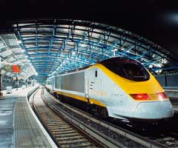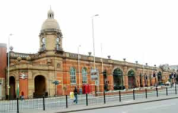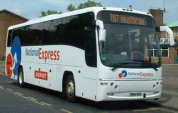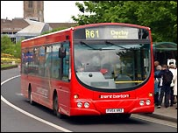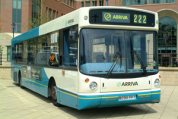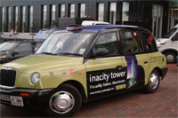
Conference Location
 Leicester , is a city and unitary authority area in the East Midlands of England. It is the county town of Leicestershire. The city lies on the River Soar and at the edge of the National Forest. In 2004, the population of the city proper was estimated at 285,100, with 441,213 living in the wider Leicester Urban Area, making Leicester the most populous city in the East Midlands, the 10th most populous settlement in the UK and the 8th largest in England alone.
Leicester , is a city and unitary authority area in the East Midlands of England. It is the county town of Leicestershire. The city lies on the River Soar and at the edge of the National Forest. In 2004, the population of the city proper was estimated at 285,100, with 441,213 living in the wider Leicester Urban Area, making Leicester the most populous city in the East Midlands, the 10th most populous settlement in the UK and the 8th largest in England alone.
HistoryLeicester is one of the oldest cities in England, with a history going back at least 2000 years. The first known name of the city is the Roman label Ratae Coritanorum. Before being settled by Romans it was that capital of the Celtic Corieltauvi tribe ruling over roughly the same territory as what is now known as the East Midlands. According to Geoffrey of Monmouth, a mythical king of the Britons King Leir founded the city of Kaerleir ('Leir's chester' – i.e. fortified town). Even today the name of the city in the Welsh language is Caerlŷr. Leir was supposedly buried by Queen Cordelia in a chamber beneath the River Soar near the city dedicated to the Roman god Janus, and every year people celebrated his feast-day near Leir's tomb. William Shakespeare's King Lear is loosely based on this story and there is a statue of Lear in Watermead Country Park. |
|
The Roman city of Ratae Corieltauvorum was founded around AD 50 as a military settlement upon the Fosse Way Roman road. After the military departure, Ratae Corieltauvorum grew into an important trading centre and one of the largest towns in Roman Britain. The remains of the baths of Roman Leicester can be seen at the Jewry Wall and other Roman artefacts are displayed in the Jewry Wall Museum adjacent to the site.
|
|
Knowledge of the town in the 5th century is very patchy. Certainly there is some continuation of occupation of the town, though on a much reduced scale in the 5th and 6th centuries. Leicester was chosen as the centre of a bishopric (and therefore a city) in 679/80 which survived until the 9th century, when Leicester was captured by the Danes (Vikings) and became one of the five boroughs (fortified towns) of Danelaw, although this position was short lived. The Saxon Bishop of Leicester fled to Dorchester-on-Thames and Leicester was not to become a bishopric again until the 20th century. |
|
Leicester became a town of considerable importance by Medieval times. It was mentioned in the Domesday Book as 'civitas' (city), but Leicester lost its city status in the 11th century owing to power struggles between the Church and the aristocracy. It was eventually re-made a city in 1919, and the Church of St Martin became Leicester Cathedral in 1927. The tomb of King Richard III is located in the central nave of the church although he is not actually buried there. He was originally buried in the Greyfriars Church in Leicester, but there is a legend that his corpse was exhumed under orders from Henry VII and cast into the River Soar, although there is no evidence for this and some historians believe that his tomb and bones were destroyed with the dissolution of the church. Leicester played a significant role in the history of England, when, in 1265, Simon de Montfort forced King Henry III to hold the first Parliament of England at the now-ruined Leicester Castle. Lady Jane Grey, (1536/7 — 12 February 1554), a great-granddaughter of Henry VII of England, reigned as uncrowned Queen Regnant of the Kingdom of England for nine days in July 1553, and for that reason is called "The Nine Days Queen"[3] was born at Bradgate Park near Leicester. |
|
|
|
On 4 November 1530, Cardinal Thomas Wolsey was arrested on charges of treason and taken from York Place. On his way south to face dubious justice at the Tower of London, he fell ill. The group escorting him was concerned enough to stop at Leicester. There, Wolsey's condition quickly worsened and he died on 29 November 1530 and was buried at Leicester Abbey, now Abbey Park. Leicester was a Parliamentarian stronghold during the English Civil War. In 1645, Prince Rupert decided to attack the city to draw the New Model Army away from the Royalist headquarters of Oxford. Royalist guns were set up on Raw Dykes and after an unsatisfactory response to a demand for surrender, the Newarke was stormed and the city was sacked on 30 May. Although hundreds of people were killed by Rupert's cavalry, reports of the severity of the sacking were exaggerated by the Parliamentary press in London. |
|
The construction of the Grand Union Canal in the 1790s linked Leicester to London and Birmingham and by 1832 the railway had arrived in Leicester; the new Leicester and Swannington Railway providing a supply of coal to the town from nearby collieries. By 1840 the Midland Counties Railway had linked Leicester to the national railway network and by the 1860s, Leicester had gained a direct rail link to London (St Pancras) with the completion of the Midland Main Line. |
|
|
|
These developments in transport encouraged and accompanied a process of industrialisation which intensified throughout the reign of Queen Victoria (1837-1901). Factories began to appear, particularly along the canal and the River Soar. Between 1861 and 1901 Leicester's population increased from 68,000 to 212,000 and the proportion employed in trade, commerce, building and the city's new factories and workshops rose steadily. Hosiery, textiles and footwear became major industrial employers joined, in the latter part of the century, by engineering. Years of consistent economic growth meant that, for many, living standards increased. The second half of the nineteenth-century also witnessed the creation of many public institutions. By the time of Queen Victoria's death in 1901 the rapid population growth of the previous decades had already began to slow and the Great War of 1914-18 and its aftermath had a marked social and economic impact. Leicester's diversified economic base and lack of dependence on primary industries meant that it was much better placed than many other cities to weather the severe economic challenges of the 1920s and 30s. The Bureau of Statistics of the newly-formed League of Nations identified Leicester in 1936 as the second richest city in Europe and it became an attractive destination for refugees fleeing persecution and political turmoil in continental Europe. |
|
The years after World War II, particularly from the 1960s onwards, brought many social and economic challenges. There was a steady and irreversible decline in Leicester's traditional manufacturing industries and in the City Centre working factories and light industrial premises have now been almost entirely displaced by new businesses. The 1960s and 70s saw the movement of passengers and freight by rail and barge eclipsed by the growth of road transport. The Great Central Railway and the Leicester and Swannington Railway both closed and the northward extension of the M1 motorway linked Leicester into a growing motorway network. By the 1990s Leicester's central position and its good road transport links to the rest of the country had given it a new strategic importance as a distribution centre and the south western boundaries of the city have attracted many new businesses in both service and manufacturing sectors. Since the war Leicester has experienced large scale immigration from across the world. Immigrant groups today make up around 40% of Leicester's population, making Leicester one of the most ethnically diverse cities in the United Kingdom. |
|
|
|
Today, Leicester is a thriving city, located on Midland Main Line and close to the M1 motorway. Leicester has an ethnically diverse population, a product of immigration to the United Kingdom since the Second World War. The city has a large South Asian community, and as such many Hindu, Sikh and Muslim places of worship. Leicester is a centre for higher education by way of Leicester University, De Montfort University, and Loughborough University, all based in the region. |
Parts of this text were copied from 
Conference Venue
|
|
The ESM'2009 Conference will be held at |
How to reach Leicester and the conference venue 
By Plane |
When arriving by plane in the UK you are mostly destined to arrive in London either at Heathrow, Stansted, Gatwick or Luton Airport. From these airports you need to make your way by train or tube to St.Pancras Station from where you can take a direct train to Leicester. However, if you come by plane the closest airports are either Birmingham Airport or East Midlands Airport, which is really the closest to Leicester and only about 7-8 miles away from the town. There are several ways you can get from the airport to Leicester as are shown here. |
By Train |
When taking the train to the United Kingdom, you will be using the EUROSTAR service arriving at St.Pancras station. After clearing customs and passport control you leave the EUROSTAR part of the station, turn right and up the escalators for all northbound trains to Leeds, Sheffield and Nottingham on East Midland Trains. You can take a direct train to Leicester. If you come from Birmingham then take a train from the airport to Birmingham New Street Station. (See Journeyplanner to work out your itinerary).
|
By Coach and Bus |
A number of coach companies travel to and from Leicester from most major cities. Inter city coaches and local buses arrive at two termini for local bus services:St Margaret's Bus Station in Gravel Street which is fairly close to the centre of the city, and the Haymarket Bus Terminus in Charles Street (at the Haymarket Shopping Centre.)
National coach services
Local bus services ARRIVA Fox County operates an extensive network of bus services throughout Leicestershire. For timetable information phone Traveline (below). Tel: 0116 253 9534 or 0116 264 0400Â / Fax: 0116 260 5605 Information about Regional Bus and Coach services
|
By Taxi |
A number of companies can be contacted following these links:
|
By Car |
Leicester has the M1 (junction 21) and the M69 motorways intersecting just outside the city so it is easily reachable by car.
|
On Foot
|
As Leicester city centre is quite small in comparison to the entire Leicester area, all locations are easily reachable on foot. The Hotel as well as De Montfort University. |
Leicester Maps
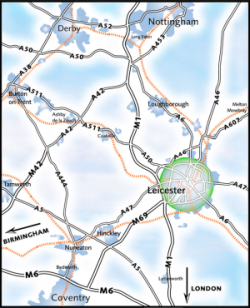
|

|
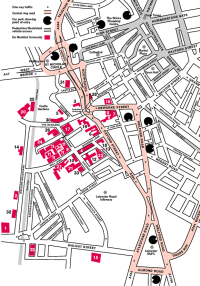
|
Click on the maps above for a more detailed view

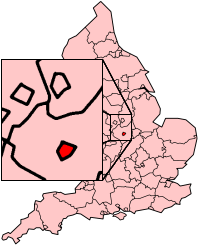
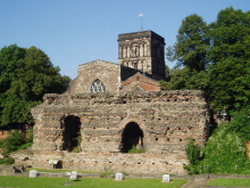
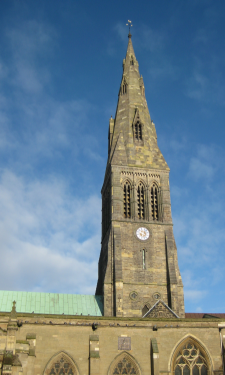
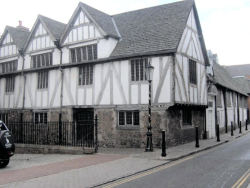
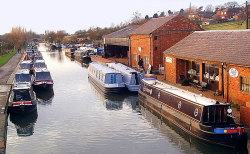

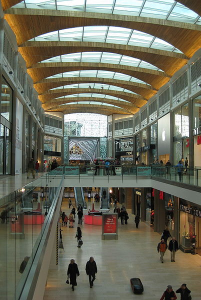
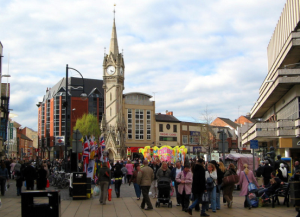
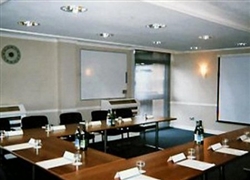
 Tel: +44-871-9429048
Tel: +44-871-9429048 Fax: +44-116-2513169
Fax: +44-116-2513169 Email:
Email:
